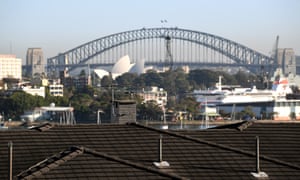Hobart was the only Australian capital to record a rise in house prices in the last quarter while Canberra home values were flat and other cities went backwards, according to new data.
Sydney and Melbourne house prices dipped by 4.1% each in the past three months, while Hobart was up 1.1%, data researcher CoreLogic reported.
The weakest-performing capital city was Darwin where house values declined by 5.1%.
Nationally there was a 0.7% drop in dwelling values in February, which takes the overall decline to -6.8% since a peak in October 2017.
“The fact that we are seeing weakening housing market conditions across regions where home values were previously rising at a sustainable pace and economic conditions are relatively healthy, is a sign that tighter credit conditions are having a broad dampening effect on buyer activity,” head of research, Tim Lawless, said.
On an annual basis Hobart prices were up by 7.2%, Adelaide and Canberra values were in positive territory, but other cities were going in reverse.
Lawless said Brisbane was showing a negative annual trend for the first time since 2012. Sydney’s market moved into double digit declines for the first time since the early 1980s.
“If Melbourne’s downturn continues at a similar pace we are likely to see the annual decline move into double-digit falls over the coming months as well, with values currently 9.1% lower over the year,” he said.
House prices in regional Tasmania and larger cities surrounding Melbourne were recording strong growth because of lifestyle and affordability appeal.
South-east Tasmanian prices were up 9% and Ballarat 7.9%.
The report identified Canberra and Hobart as the tightest rental markets, with tenants paying an extra 4.7% and 4.6% respectively compared with a year ago.
“The February housing market results marked a subtle improvement in the rate of decline, however the housing market downturn is now more widespread geographically and we aren’t seeing any indicators pointing to the market bottoming out just yet,” he said.
He said the long-running reduction in investment lending had impacted the Sydney and Melbourne housing markets more than others.
“Stricter lending standards are a logical outcome following the [banking] royal commission and we are likely in the early phases of a ‘new normal’ for mortgage lending where borrowers will face closer scrutiny around their expenses and ability to service a loan and conversion rates on loan applications are likely to remain lower than they have been over prior years,” Lawless said.
Since you’re here…
… we have a small favour to ask. More people are reading and supporting our independent, investigative reporting than ever before. And unlike many news organisations, we have chosen an approach that allows us to keep our journalism accessible to all, regardless of where they live or what they can afford.
The Guardian is editorially independent, meaning we set our own agenda. Our journalism is free from commercial bias and not influenced by billionaire owners, politicians or shareholders. No one edits our editor. No one steers our opinion. This is important as it enables us to give a voice to those less heard, challenge the powerful and hold them to account. It’s what makes us different to so many others in the media, at a time when factual, honest reporting is critical.
Every contribution we receive from readers like you, big or small, goes directly into funding our journalism. This support enables us to keep working as we do – but we must maintain and build on it for every year to come.

